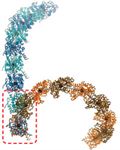
Staph, e-coli, meningitis, MRSA and botulism are just a few of the thousands of bacterial infections that plague people all over the world.
For example, almost 23,300 people in the United States were sickened by food-borne bacterial illnesses in 2008, according to the Centers for Disease Control.
But a recent paper in the Proceedings of the National Academy of Sciences by a UC Merced professor and colleagues at Stanford University describes how a critical component of bacterial cell division works. That research could lead to figuring out how to control bacterial population growth.
“It’s not the first few bacteria that get you,” said physics Professor Ajay Gopinathan, “it’s when they multiply.”
The ability to manipulate bacterial growth could eventually have huge implications for preventing and treating a multitude of medical conditions.
Gopinathan first got involved in this project while on sabbatical at Stanford University in Spring 2011. He joined his Stanford bioengineering colleague K.C. Huang and Huang’s postdoctoral student Jennifer Hsin, who were performing detailed simulations of a protein essential to divide bacterial cells. Picture a capsule that pinches in the middle, forming two new capsules.
Like all other dividing cells, bacterial cells split to form more of themselves. But where human cells have “motors” that drive the splitting, bacterial cells do not. They use a filament-like protein called FtsZ, which is a long chain of identical units that coils in on itself to split the cell, like a purse-string drawing shut.
FtsZ units binds to two kinds of “fuel cell” molecules called GTP and GDP. The researchers discovered that when the individual FtsZ units are bound to GTP, the filament remains in a straight line. But as the GTP fuel is spent and becomes GDP, the filament bends, forming the coil that divides the cell.
“This work gives us a fundamental understanding of the bacterial cell division process that we did not have before.” Gopinathan said. “The paper was on the theory, and now experiments will get us closer to being able to design therapies and drugs that manipulate cell division.”
“While more work is indeed needed, this is exactly the kind of basic research that will ultimately pave the way for practical applications,” said Sam Traina, UC Merced’s vice chancellor for research. “We are extremely proud of this accomplishment of Professor Gopinathan and his colleagues.”
Huang and Hsin are conducting further experiments, and Gopinathan said he will continue to work with them, although he’s back on the UC Merced campus now, where he works with eight students, ranging from undergrads to postdoctoral students, on their own research projects and teaches classes.
Lorena Anderson

Senior Writer and Public Information Representative
Office: (209) 228-4406
Mobile: (209) 201-6255






